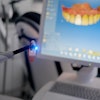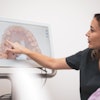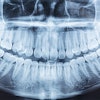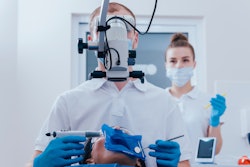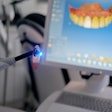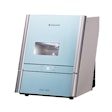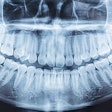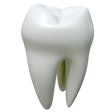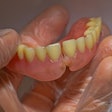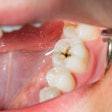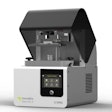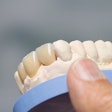A method for complete arch implant scanning uses a screw-retained custom scan body to achieve precise virtual alignment and a repeatable reference point through a fully digital workflow. This research was published in the Journal of Prosthetic Dentistry.
The 10-step technique is noninvasive, easy to use, suitable for patients with no teeth on the upper and lower jaws, and cuts down on errors, the authors wrote.
“The technique is accomplished by relating the geometric position of scan bodies, the interim prosthesis, and the custom scan body with a completely digital workflow,” wrote the author, Abdullah H. Alnasser of the Prince Sattam bin Abdulaziz University College of Dentistry in Saudi Arabia (J Prosthet Dent, June 10, 2024).
The technique
Attach a CARES Mono Scanbody to an implant analog and scan it with a Desktop scanner D800. Export the STL file and import it into DentalCAD. Identify the scan body and design a coping to fit the screw-retained abutment. Export the coping's STL file and import it into Meshmixer to design a custom scan body with four cylindrical bases, each topped with a hemisphere and a small dimple. Connect the cylinders with a bar, linking the three on the labial side with a bridge. Export the custom scan body STL file for 3D printing using high-precision dental cast resin. Attach the abutment screw to the custom scan body.
For the sectioned prosthesis, scan the intaglio and cameo surfaces of the conversion prosthesis using an intraoral scanner, export the STL files, and import them into the model editing software. Virtually section the anterior segment at the most anterior implant and connect the two posterior segments with a bar. Export the sectioned prosthesis STL file and 3D print it using hybrid resin.
Evaluate the occlusal vertical dimension (OVD) and occlusion of the existing prostheses in the patient’s mouth. If the OVD is optimal, scan the existing conversion prostheses in the patient’s mouth using an intraoral scanner and capture the interocclusal relationship in the centric relation (CR) position (first scan).
Remove the existing prostheses and tighten the abutments to 35 Ncm as per manufacturer recommendations. Attach the custom scan body to the most anterior abutment and tighten it by hand. Place the sectioned prosthesis on the posterior abutments, ensuring stability without rocking and without touching the custom scan body. Perform a complete arch scan of the sectioned prosthesis and custom scan body (second scan).
Remove the sectioned prosthesis, leaving the custom scan body in place. Secure the scan bodies intraorally on the posterior implants and scan them with the custom scan body (third scan).
Replace the custom scan body with an abutment scan body and perform a complete arch scan (fourth scan).
Repeat the steps for both arches and export the scan files.
Using the CAD program, import the STL files of the existing prosthesis (first scan), then the sectioned prosthesis with the custom scan body (second scan). Align the sectioned prosthesis to the existing prosthesis by selecting three points.
After aligning the sectioned prosthesis scans, import the third scan and align it by selecting four points on the dimples of the custom scan body.
Align the fourth scan by selecting four points on the posterior scan bodies, creating a digital articulation of the scans. Design the maxillary and mandibular implant-supported prostheses to match the existing prostheses. Use a CAM device to mill the interim prostheses and evaluate the fit visually, radiographically, with a one-screw test, and a screw resistance test. After confirming the passive fit of the interim prosthesis, evaluate the OVD, esthetics, and phonetics.
“The main advantages of this technique include its noninvasive nature, the ease of application, the ability to use it in both edentulous jaws, and the reduction of errors by precisely placing the alignment points on the dimples located on top of the device,” Alnasser concluded.

